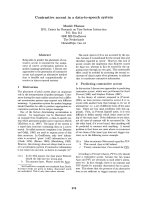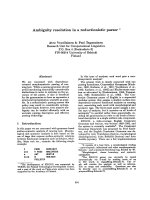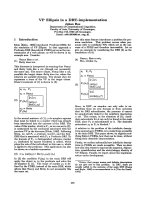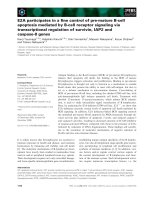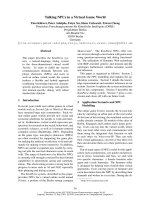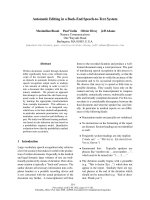Báo cáo khoa học: "Turn-Taking Cues in a Human Tutoring Corpus" potx
Bạn đang xem bản rút gọn của tài liệu. Xem và tải ngay bản đầy đủ của tài liệu tại đây (187.2 KB, 5 trang )
Proceedings of the ACL-HLT 2011 Student Session, pages 94–98,
Portland, OR, USA 19-24 June 2011.
c
2011 Association for Computational Linguistics
Turn-Taking Cues in a Human Tutoring Corpus
Heather Friedberg
Department of Computer Science
University of Pittsburgh
Pittsburgh, PA, 15260, USA
Abstract
Most spoken dialogue systems are still
lacking in their ability to accurately model
the complex process that is human turn-
taking. This research analyzes a human-
human tutoring corpus in order to identify
prosodic turn-taking cues, with the hopes
that they can be used by intelligent tutoring
systems to predict student turn boundaries.
Results show that while there was variation
between subjects, three features were sig-
nificant turn-yielding cues overall. In addi-
tion, a positive relationship between the
number of cues present and the probability
of a turn yield was demonstrated.
1 Introduction
Human conversation is a seemingly simple, every-
day phenomenon that requires a complex mental
process of turn-taking, in which participants man-
age to yield and hold the floor with little pause in-
between speaking turns. Most linguists subscribe
to the idea that this process is governed by a sub-
conscious internal mechanism, that is, a set of cues
or rules that steers humans toward proper turn-
taking (Duncan, 1972). These cues may include
lexical features such as the words used to end the
turn, or prosodic features such as speaking rate,
pitch, and intensity (Cutler and Pearson, 1986).
While successful turn-taking is fairly easy for
humans to accomplish, it is still difficult for mod-
els to be implemented in spoken dialogue sys-
tems. Many systems use a set time-out to decide
when a user is finished speaking, often resulting in
unnaturally long pauses or awkward overlaps
(Ward, et. al., 2005). Others detect when a user
interrupts the system, known as “barge-in”, though
this is characteristic of failed turn-taking rather
than successful conversation (Glass, 1999).
Improper turn-taking can often be a source of us-
er discomfort and dissatisfaction with a spoken
dialogue system. Little work has been done to
study turn-taking in tutoring, so we hope to inves-
tigate it further while using a human-human (HH)
tutoring corpus and language technologies to ex-
tract useful information about turn-taking cues.
This analysis is particularly interesting in a tutor-
ing domain because of the speculated unequal sta-
tuses of participants. The goal is to eventually
develop a model for turn-taking based on this anal-
ysis which can be implemented in an existent tutor-
ing system, ITSPOKE, an intelligent tutor for
college-level Newtonian physics (Litman and Sil-
liman, 2004). ITSPOKE currently uses a time-out
to determine the end of a student turn and does not
recognize student barge-in. We hypothesize that
improving upon the turn-taking model this system
uses will help engage students and hopefully lead
to increased student learning, a standard perfor-
mance measure of intelligent tutoring systems
(Litman et. al., 2006).
2 Related Work
Turn-taking has been a recent focus in spoken di-
alogue system work, with research producing
many different models and approaches. Raux and
Eskenazi (2009) proposed a finite-state turn-taking
94
model, which is used to predict end-of-turn and
performed significantly better than a fixed-
threshold baseline in reducing endpointing latency
in a spoken dialogue system. Selfridge and Hee-
man (2010) took a different approach and pre-
sented a bidding model for turn-taking, in which
dialogue participants compete for the turn based on
the importance of what they will say next.
Of considerable inspiration to the research in this
paper was Gravano and Hirschberg’s (2009) analy-
sis of their games corpus, which showed that it was
possible for turn-yielding cues to be identified in
an HH corpus. A similar method was used in this
analysis, though it was adapted based on the tools
and data that were readily available for our corpus.
Since these differences may prevent direct compar-
ison between corpora, future work will focus on
making our method more analogous.
Since our work is similar to that done by Grava-
no and Hirschberg (2009), we hypothesize that
turn-yielding cues can also be identified in our HH
tutoring corpus. However, it is possible that the
cues identified will be very different, due to factors
specific to a tutoring environment. These include,
but are not limited to, status differences between
the student and tutor, engagement of the student,
and the different goals of the student and tutor.
Our hypothesis is that for certain prosodic fea-
tures, there will be a significant difference between
places where students yield their turn (allow the
tutor to speak) and places where they hold it (con-
tinue talking). This would designate these features
as turn-taking cues, and would allow them to be
used as features in a turn-taking model for a spo-
ken dialogue system in the future.
3 Method
The data for this analysis is from an HH tutoring
corpus recorded during the 2002-2003 school
year. This is an audio corpus of 17 university stu-
dents, all native Standard English speakers, work-
ing with a tutor (the same for all subjects) on
physics problems (Litman et. al., 2006). Both the
student and the tutor were sitting in front of sepa-
rate work stations, so they could communicate only
through microphones or, in the case of a student-
written essay, through the shared computer envi-
ronment. Any potential turn-taking cues that the
tutor received from the student were very compa-
rable to what a spoken dialogue system would have
to analyze during a user interaction.
For each participant, student speech was iso-
lated and segmented into breath groups. A breath
group is defined as any segment of speech by one
dialogue participant bounded by 200 ms of silence
or more based on a certain threshold of intensity
(Liscombe et. al., 2005). This break-down allowed
for feature measurement and comparison at places
that were and were not turn boundaries. Although
Gravano and Hirschberg (2009) segmented their
corpus by 50 ms of silence, we used 200 ms to di-
vide the breath groups, as this data had already
been calculated for another experiment done with
the HH corpus (Liscombe et. al., 2005).
1
Figure 1. Conversation Segmented into Breath Groups
Each breath group was automatically labeled as
one of the following: HOLD, when a breath group
was immediately followed by a second breath
group from the same person, YIELD, when a
breath group was immediately followed by speech
from the other participant, or OVERLAP, when
speech from another participant started before the
current one ended. Figure 1 is a diagram of a hy-
pothetical conversation between two participants,
with examples of HOLD’s and YIELD’s labeled.
These groups were determined strictly by time and
not by the actually speech being spoken. Speech
acts such as backchannels, then, would be included
in the YIELD group if they were spoken during
clear gaps in the tutor’s speech, but would be
placed in the OVERLAP group if they occurred
during or overlapping with tutor speech. There
were 9,169 total HOLD's in the corpus and 4,773
YIELD’s; these were used for comparison, while
the OVERLAP’s were set aside for future work.
Four prosodic features were calculated for each
breath group: duration, pitch, RMS, and percent
silence. Duration is the length of the breath group
in seconds. Pitch is the mean fundamental fre-
quency (f0) of the speech. RMS (the root mean
1
Many thanks to the researchers at Columbia University for
providing the breath group data for this corpus.
95
squared amplitude) is the energy or loudness. Per-
cent silence was the amount of internal silence
within the breath group. For pitch and RMS, the
mean was taken over the length of the breath
group. These features were used because they are
similar to those used by Gravano and Hirschberg
(2009), and are already used in the spoken dialo-
gue system we will be using (Forbes-Riley and
Litman, 2011). While only a small set of features
is examined here, future work will include expand-
ing the feature set.
Mean values for each feature for HOLD’s and
YIELD’s were calculated and compared using the
student T-test in SPSS Statistics software. Two
separate tests were done, one to compare the
means for each student individually, and one to
compare the means across all students. p ≤ .05 is
considered significant for all statistical tests. The
p-values given are the probability of obtaining the
difference between groups by chance.
4 Results
4.1 Individual Cues
First, means for each feature for HOLD’s and
YIELD’s were compared for each subject indivi-
dually. These individual results indicated that
while turn-taking cues could be identified, there
was much variation between students. Table 1
displays the results of the analysis for one subject,
student 111. For this student, all four prosodic fea-
tures are turn-taking cues, as there is a significant
different between the HOLD and YIELD groups
for all of them. However, for all other students,
this was not the case. As shown in Table 3, mul-
tiple significant cues could be identified for most
students, and there was only one which appeared to
have no significant turn-yielding cues.
Because there was so much individual variation,
a paired T-test was used to compare the means
across subjects. In this analysis, duration, pitch,
and RMS were all found to be significant cues.
Percent silence, however, was not. The results of
this test are summarized in Table 2. A more de-
tailed look at each of the three significant cues is
done below.
Number of
Significant Cues
Number of
Students
0
1
1
0
2
6
3
9
4
1
Table 3. Number of Students with
Significant Cues
Duration: The mean duration for HOLD’s is
longer than the mean duration for YIELD’s. This
suggests that students speak for a longer uninter-
rupted time when they are trying to hold their turn,
and yield their turns with shorter utterances. This is
the opposite of Gravano and Hirschberg’s (2009)
results, which found that YIELD’s were longer.
Pitch: The mean pitch for YIELD’s is higher
than the mean pitch for HOLD’s. Gravano and
Hirschberg (2009), on the other hand, found that
YIELD’s were lower pitched than HOLD’s. This
difference may be accounted for by the difference
in tasks. During tutoring, students are possibly
N
duration
percent silence
pitch
RMS
HOLD Group Mean
993
1.07
0.34
102.24
165.27
YIELD Group Mean
480
0.78
0.39
114.87
138.89
Significance
* p = 0.018
* p < 0.001
* p < 0.001
* p < 0.001
Table 1. Individual Results for Subject 111
* denotes a significant p value
N
duration
percent silence
pitch
RMS
HOLD Group Mean
17
1.49
0.300
140.44
418.00
YIELD Group Mean
17
0.82
0.310
147.58
354.65
Significance
* p = 0.022
p = 0.590
* p = 0.009
* p < 0.001
Table 2. Results from Paired T-Test
96
more uncertain, which may raise the mean pitch of
the YIELD breath groups.
RMS: The mean RMS, or energy, for HOLD’s is
higher than the mean energy for YIELD’s. This is
consistent with student’s speaking more softly, i.e.,
trailing off, at the end of their turn, a usual pheno-
menon in human speech. This is consistent with
the results from the Columbia games corpus (Gra-
vano and Hirshberg, 2009).
4.2 Combining Cues
Gravano and Hirschberg (2009) were able to show
using their cues and corpus that there is a positive
relationship between the number of turn-yielding
cues present and the probability of a turn actually
being taken. This suggests that in order to make
sure that the other participant is aware whether the
turn is going to continue or end, the speaker may
subconsciously give them more information
through multiple cues.
To see whether this relationship existed in our
data, each breath group was marked with a binary
value for each significant cue, representing wheth-
er the cue was present or not present within that
breath group. A cue was considered present if the
value for that breath group was strictly closer to
the student’s mean for YIELD’s than
HOLD’s. The number of cues present for each
breath group was totaled. Only the three cues
found to be significant cues were used for these
calculations. For each number of cues possible x
(0 to 3, inclusively), the probability of the turn be-
ing taken was calculated by p(x) = Y / T, where Y is
the number of YIELD’s with x cues present, and T
is the total number of breath groups with x cues
present.
Figure 2. Cues Present v. Probability of YIELD
According to these results, a positive relationship
seems to exist for these cues and this corpus. Fig-
ure 2 shows the results plotted with a fitted regres-
sion. The number of cues present and probability
of a turn yield is strongly correlated (r = .923,
p=.038). A regression analysis done using SPSS
showed that the adjusted r
2
= .779 (p = .077).
When no turn-yielding cues are present, there is
still a majority chance that the student will yield
their turn; however, this is understandable due to
the small number of cues being analyzed. Regard-
less, this gives a very preliminary support for the
idea that it is possible to predict when a turn will
be taken based on the number of cues present.
5 Conclusions
This paper presented preliminary work in using an
HH tutoring corpus to construct a turn-taking mod-
el that can later be implemented in a spoken dialo-
gue system. A small set of prosodic features was
used to try and identify turn-taking cues by com-
paring their values at places where students yielded
their turn to the tutor and places where they held
it. Results show that turn-taking cues such as those
investigated can be identified for the corpus, and
may hold predictive ability for turn boundaries.
5.1 Future Work
When building on this work, there are two differ-
ent directions in which we can go. While this
work uncovers some interesting results in the tutor-
ing domain, there are some shortcomings in the
method that may make it difficult to effectively
evaluate the results. As the breath group is differ-
ent from the segment used in Gravano and Hir-
schberg’s (2009) experiment, and the set of
prosodic features is smaller, direct comparison be-
comes quite difficult. The differences between the
two methods provide enough doubt for the results
to truly be interpreted as contradictory. Thus the
first line of future inquiry is to redo this method
using a smaller silence boundary (50 ms) and dif-
ferent set of prosodic features so that it is truly
comparable to Gravano and Hirschberg’s (2009)
work with the game corpus. This could yield in-
teresting discoveries in the differences between the
two corpora, shedding light on phenomena that are
particular to tutoring scenarios.
On the other hand, other researchers have used
different segments; for example, Clemens and Di-
ekhaus (2009) divide their corpus by “topic units”
that are grammatically and semantically complete.
In addition, Litman et. al. (2009) were able to use
60.00%
70.00%
80.00%
90.00%
100.00%
0
1
2
3
97
word-level units to calculate prosody and classify
turn-level uncertainty. Perhaps direct comparison
is not entirely necessary, and instead this work
should be considered an isolated look at an HH
corpus that provides insight into turn-taking, spe-
cifically in tutoring and other domains with un-
equal power levels. Future work in this direction
would include growing the set of features by add-
ing more prosodic ones and introducing lexical
ones such as bi-grams and uni-grams. Already,
work has been done to investigate the features used
in the INTERSPEECH 2009 Emotion Challenge
using openSMILE (Eyben et. al., 2009). When a
large feature bank has been developed, significant
cues will be used in conjunction with machine
learning techniques to build a model for turn-
taking which can be implemented in a spoken di-
alogue tutoring system. The goal would be to learn
more about human turn-taking while seeing if bet-
ter turn-taking by a computer tutor ultimately leads
to increased student learning in an intelligent tutor-
ing system.
Acknowledgments
This work was supported by the NSF (#0631930).
I would like to thank Diane Litman, my advisor,
Scott Silliman, for software assistance, Joanna
Drummond, for many helpful comments on this
paper, and the ITSPOKE research group for their
feedback on my work.
References
Caroline Clemens and Christoph Diekhaus. 2009. Pro-
sodic turn-yielding Cues with and without optical
Feedback. In Proceedings of the SIGDIAL 2009 Con-
ference: The 10th Annual Meeting of the Special In-
terest Group on Discourse and Dialogue.
Association for Computational Linguistics.
Anne Cutler and Mark Pearson. 1986. On the analysis
of prosodic turn-taking cues. In C. Johns-Lewis, Ed.,
Intonation in Discourse, pp. 139-156. College-Hill.
Starkey Duncan. 1972. Some signals and rules for tak-
ing speaking turns in conversations. Journal of Per-
sonality and Social Psychology, 24(2):283-292.
Florian Eyben, Martin Wöllmer, Björn Schuller. 2010.
openSMILE - The Munich Versatile and Fast Open-
Source Audio Feature Extractor. Proc. ACM Multi-
media (MM), ACM, Florence, Italy. pp. 1459-1462.
James R. Glass. 1999. Challenges for spoken dialogue
systems. In Proceedings of the 1999 IEEE ASRU
Workshop.
Agustín Gravano and Julia Hirschberg. 2009. Turn-
yielding cues in task-oriented dialogue. In Proceed-
ings of the SIGDIAL 2009 Conference: The 10th An-
nual Meeting of the Special Interest Group on
Discourse and Dialogue, 253 261. Association for
Computational Linguistics.
Jackson Liscombe, Julia Hirschberg, and Jennifer J.
Venditti. 2005. Detecting certainness in spoken tu-
torial dialogues. In Interspeech.
Diane J. Litman, Carolyn P. Rose, Kate Forbes-Riley,
Kurt VanLehn, Dumisizwe Bhembe, and Scott Silli-
man. 2006. Spoken Versus Typed Human and Com-
puter Dialogue Tutoring. In International Journal of
Artificial Intelligence in Education, 26: 145-170.
Diane Litman, Mihai Rotaru, and Greg Nicholas.
2009. Classifying Turn-Level Uncertainty Using
Word-Level Prosody. Proceedings Interspeech,
Brighton, UK, September.
Kate Forbes-Riley and Diane Litman. 2011. Benefits
and Challenges of Real-Time Uncertainty Detection
and Adaptation in a Spoken Dialogue Computer Tu-
tor. Speech Communication, in press.
Diane J. Litman and Scott Silliman. 2004. Itspoke: An
intelligent tutoring spoken dialogue system. In
HLT/NAACL.
Antoine Raux and Maxine Eskenazi. 2009. A finite-state
turn-taking model for spoken dialog systems. In
Proc. NAACL/HLT 2009, Boulder, CO, USA.
Ethan O. Selfridge and Peter A. Heeman. 2010. Impor-
tance-Driven Turn-Bidding for spoken dialogue sys-
tems. In Proceedings of the 48th Annual Meeting of
the Association for Computational Linguistics (ACL
'10). Association for Computational Linguistics,
Stroudsburg, PA, USA, 177-185.
Nigel Ward, Anais Rivera, Karen Ward, and David G.
Novick. 2005. Root causes of lost time and user
stress in a simple dialog system. In Proceedings of
Interspeech.
98


